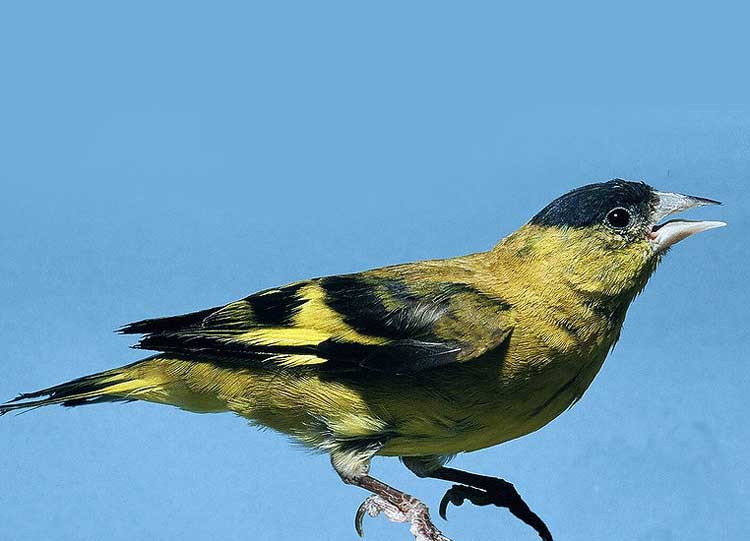
Spinus spinescens (*)
Superregnum: Eukaryota
Cladus: Unikonta
Cladus: Opisthokonta
Cladus: Holozoa
Regnum: Animalia
Subregnum: Eumetazoa
Cladus: Bilateria
Cladus: Nephrozoa
Superphylum: Deuterostomia
Phylum: Chordata
Subphylum: Vertebrata
Infraphylum: Gnathostomata
Megaclassis: Osteichthyes
Cladus: Sarcopterygii
Cladus: Rhipidistia
Cladus: Tetrapodomorpha
Cladus: Eotetrapodiformes
Cladus: Elpistostegalia
Superclassis: Tetrapoda
Cladus: Reptiliomorpha
Cladus: Amniota
Classis: Reptilia
Cladus: Eureptilia
Cladus: Romeriida
Subclassis: Diapsida
Cladus: Sauria
Infraclassis: Archosauromorpha
Cladus: Crurotarsi
Divisio: Archosauria
Cladus: Avemetatarsalia
Cladus: Ornithodira
Subtaxon: Dinosauromorpha
Cladus: Dinosauriformes
Cladus: Dracohors
Cladus: Dinosauria
Ordo: Saurischia
Cladus: Eusaurischia
Subordo: Theropoda
Cladus: Neotheropoda
Cladus: Averostra
Cladus: Tetanurae
Cladus: Avetheropoda
Cladus: Coelurosauria
Cladus: Tyrannoraptora
Cladus: Maniraptoromorpha
Cladus: Maniraptoriformes
Cladus: Maniraptora
Cladus: Pennaraptora
Cladus: Paraves
Cladus: Eumaniraptora
Cladus: Avialae
Infraclassis: Aves
Cladus: Euavialae
Cladus: Avebrevicauda
Cladus: Pygostylia
Cladus: Ornithothoraces
Cladus: Ornithuromorpha
Cladus: Carinatae
Parvclassis: Neornithes
Cohors: Neognathae
Cladus: Neoaves
Cladus: Telluraves
Cladus: Australaves
Ordo: Passeriformes
Subordo: Passeri
Infraordo: Passerida
Superfamilia: Passeroidea
Familia: Fringillidae
Subfamilia: Carduelinae
Genus: Spinus
Species: Spinus spinescens
Subspecies: S. s. capitanea – S. s. nigricauda – S. s. spinescens
Name
Spinus spinescens (Bonaparte, 1850)
Synonyms
Chrysomitris spinescens (protonym)
Carduelis spinescens
References
Bonaparte, C.L. 1850. Conspectus generum avium. Tome I. pp. [1–5], 1–543. Lugduni Batavorum (Leida). (E.J. Brill). p. 517 BHL Reference page.
Vernacular names
Deutsch: Andenzeisig
English: Andean Siskin
español: Jilguero Andino
français: Chardonneret des Andes
日本語: アンデスヒワ
Türkçe: And isketesi
The Andean siskin (Spinus spinescens) is a species of finch in the family Fringillidae. It is found in Colombia, Ecuador, and Venezuela. Its natural habitats are subtropical or tropical moist montane forests, subtropical or tropical high-altitude shrubland, subtropical or tropical high-altitude grassland, and heavily degraded former forest.[1]
Description
This is a small green-and-yellow finch. According to some sources, it is the smallest species of finch on average, although others give this title to the lesser goldfinch.[2] The total length can range from 9.5 to 11 cm (3.7 to 4.3 in).[3] A weight of 11.5 g (0.41 oz) may be at the high end.[2] Few standard measurements are known, although the bill has been recorded at 1.1 cm (0.43 in) and the wing chord length is reportedly around 6.4 cm (2.5 in). The Andean siskin has deep green upperparts with black and yellow coloration on the wings and tail. The adult male has a distinctive black cap. The female lacks this cap and is generally a duller olive color, with white from the belly to the undertail-coverts. The female differs from female yellow-bellied siskins in being paler and brighter, and by lacking the olive throat and yellow undertail-coverts of that species. Female hooded siskins are also similar, but the Andean has distinctive white undertail-coverts and more olive-green rather than gray overall coloration. The subspecies S. s. nigricauda is generally duller or darker green on upperparts than the nominate, and its underparts are dull green without any trace of yellow. The tail is all black, and the wings lack greenish-yellow tips to the coverts but retain bright yellow bases to the inner primaries and secondaries. The proposed subspecies S. s. capitaneus from the Sierra Nevada de Santa Marta is typically included in the nominate.
The Andean siskin's call is a typical goldfinch-like tswee or similar variation, frequently given in flight. The song, also goldfinch-like, is a lively rambling series of notes, high pitched and interspersed with rolling trills.
Range
The nominate subspecies occurs in the coastal mountains of Aragua in northern Venezuela, the Andes of western Venezuela, in the Serranía del Perijá along the Colombia-Venezuela border and in the Sierra Nevada de Santa Marta of northern Colombia, and from the eastern Andes in Colombia south to Valle, Putumayo, Nariño and Pichincha Province in Ecuador. S. s. nigricauda occurs in the northern, central and western Andes of Colombia, from Antioquia south to Caldas and possibly to northern Tolima.
Ecology
This species is common to locally common. It occurs in subtropical and páramo zones of the northern Andes. The Andean siskins is usually found between elevations of 1,800 and 3,700 m (5,900 and 12,100 ft), though occasionally ranges as low as 1,500 m (4,900 ft) in Colombia. It inhabits scrub or low bushes in open cloud or elfin forests or along the edges of forests. It may also be seen on open hillsides with scattered trees or bushes and occasionally range to edges of cultivation. Usually, the Andean siskin is found in pairs or small flocks of up to 20, occasionally mixed with other species of finch, such as hooded siskin in northern Ecuador. It often perches high in tops of trees, but generally feeds on or near the ground. This species feeds on a variety of plant seeds, with a particular fondness for Espeletia seeds and flowers.
Phylogeny
It has been obtained by Antonio Arnaiz-Villena et al.[4][5]
Notes
BirdLife International (2018). "Spinus spinescens". IUCN Red List of Threatened Species. 2018: e.T22720365A132137606. doi:10.2305/IUCN.UK.2018-2.RLTS.T22720365A132137606.en. Retrieved 13 November 2021.
Hilty, S.L. (2002). Birds of Venezuela. Princeton University Press. p. 831. ISBN 9781400834099. Retrieved 13 April 2015.
Ridgely, R.S.; Tudor, G. (2009). Field Guide to the Songbirds of South America: The Passerines. University of Texas Press. p. 680. ISBN 9780292717480. Retrieved 13 April 2015.
Zamora, J; Moscoso J; Ruiz-del-Valle V; Ernesto L; Serrano-Vela JI; Ira-Cachafeiro J; Arnaiz-Villena A (2006). "Conjoint mitochondrial phylogenetic trees for canaries Serinus spp. and goldfinches Carduelis spp. show several specific polytomies" (PDF). Ardeola. 53 (1): 1–17.
Arnaiz-Villena, Antonio; Alvarez-Tejado M.; Ruiz-del-Valle V.; García-de-la-Torre C.; Varela P.; Recio M. J.; Ferre S.; Martinez-Laso J. (1998). "Phylogeny and rapid Northern and Southern Hemisphere speciation of goldfinches during the Miocene and Pliocene Epochs" (PDF). Cell. Mol. Life Sci. 54 (9): 1031–41. doi:10.1007/s000180050230. PMID 9791543. S2CID 10654775.
References
Arnaiz-Villena, Antonio; Gomez-Prieto, Pablo; Ruiz-del-Valle, Valentin (2010). "Phylogeography of finches and sparrows". In Rechi, Leopold J. (ed.). Animal Genetics. Animal Science, Issues and Professions. New York: Nova Science Publishers. ISBN 978-1-60741-844-3. Archived from the original on 2012-09-02. Retrieved 2014-12-08.
Finches and Sparrows by Peter Clement. Princeton University Press (1999). ISBN 978-0691048789.
Retrieved from "http://en.wikipedia.org/"
All text is available under the terms of the GNU Free Documentation License

